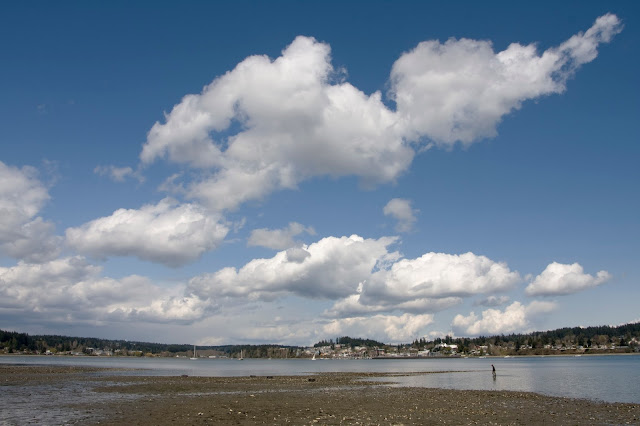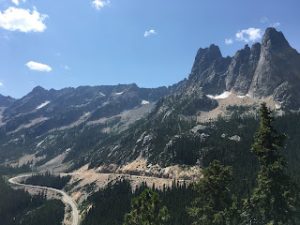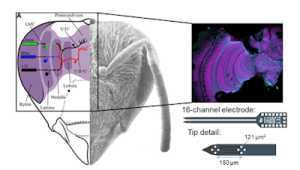Science doesn’t occur in a vacuum – unless of course it does, but not really that often in our department, that’s mostly Chemistry and Physics n’ stuff. So when I started to write this post for my own blog about a paper I authored with former Ruesink Lab member Eric Buhle (currently at NOAA), the post actually ended up being about how messy the process actually was. A nice tidy paper obscures how much blood, sweat, tears… and mud went into the process, and despite the image of scientist as lone genius, it is basically never the product of only one person’s effort. Here you can watch me start to talk about my research, then get derailed by talking about how great everyone who helped me is. Here, appearing with the permission of, and slight modification by, the author, is a post that is only just barely related to the title of this post. – Emily Grason
A lot of people, especially in the PNW, love crabs because they are tasty, but, and here is a confession that I hope nobody ever finds out: I don’t eat crabs [anymore]. I grew up in Maryland and every year for my birthday we’d pick blue crabs. I remain fiercely proud of that part of my heritage, as evidenced my collection of unused shot glasses with clever phrases about who got crabs while in Maryland. But by college I had phased all meat, including seafood, out of my diet. My crab-picking skills, earned at the cost of a thousand million cuts to that sensitive part of my fingers between the nail and last knuckle, seasoned with Old Bay and left sizzling for days(1), are moot, a party trick at best.
I love crabs because they are fierce, because they have personality, and they have a rep for holding it down in the intertidal. I enjoy feeding crabs by hand because I’m a total weirdo, and I find it completely satisfying. Here, you watch this and tell me if I’m crazy.
Super intense, right!?(2)
There are numerous examples in the literature of crabs keeping snails at bay by just straight up eating them. Thus, you might surmise, if you have read way back in this blog to the part where I used to write about actual science that I actually did, that I would be reeeeeeeally curious to see if crabs would eat any of my invasive snails – in particular my favorite Mollusca Non-Grata, the Japanese oyster drill (Ocenebra inornata(3)). Previous research, done by, *cough cough*, yours truly and Ben Miner, pointed to at least a willingness of crabs to eat these snails when you throw them in a bucket together. But that’s frankly pretty unsurprising – crabs will eat anything you throw them in a bucket with. What happens in natura(4)?
Answering that question was the goal of my summer of 2011. And if you’re wondering, gee, Emily, that was HALF OF A DECADE AGO, why are you telling us about this now? It turns out half a decade is exactly how long it took me to get this work published(5)!
I’ll set the scene: Emily, way out on a beautifully restored native oyster bed on only the sunniest of sunny PNW days, clean and well rested, scratching her chin and waxing genius about ecological dynamics of restoration.
J slash K. It was nothing like that. I had so much generous help. Second off, it never looked like I had it together out there even for a second. Field work is a slog. When you do work in the intertidal, it’s a panicked slog, as you race to get your work done before the tide comes back. In the muddy intertidal, it’s a panicked slog in painful, hilariously clumsy, slow motion as you race against the returning tide ankle deep in mud. I consider myself relatively fleet of foot in moving across mud in waders, but it’s not pretty, I assure you.
So I called for help. I had a slew of helpers:
- Nima, a classmate’s husband, who was interested in seeing what the work of scientists actually looks like. He took the beautiful picture above. I’m grateful not to have seen any close ups of what I actually looked like that day.
- Avanthi, a classmate’s girlfriend (now wife 🙂 ), who was an amazing trooper, helping me swap out oysters on very little sleep, as I recall.
- Marie, my actual classmate, she and I carried approximately 17 million tons of rebar down the shore and across the mud – how we did it, I can’t remember. I think it was one of those, “well, there’s really no one else who’s going to do it if we don’t” things.
These folks really had no idea what I was dragging them into, and they maintained good humor throughout – which is not always easy when you are following orders from a panicked grad student covered with mud and trying to simultaneously count snails, untangle 30,000 miles of nylon cord, and staunch the bleeding from a cut of unknown origin (when was my last T Dap booster?). I also had excellent logistical support from a number of people:
- Brian Allen at Puget Sound Restoration Fund helped me get access to the oyster beds, which were under PSRFs restoration care – they put out old oyster shell to provide habitat for new babies to settle on. Brian also tried his best to teach me to pilot a tiny Whaler with an outboard, and I discovered that there are some skills that I need more than 2.5 minutes to learn. To this day, I cannot operate an outboard.
- Joth who gave me sacrificial oysters from his own farm! That’s right, the shirt off his back to support graduate research.
- Molly and her father Greg, who helped ferry me said oysters.
- Jen, my advisor, who taught me how to make oyster pops, and helped me secure lots of random supplies for building cages. “Sure, you need 20 old oyster bags? Alan can bring them up from Willapa and leave them outside Kincaid”[Thanks, again Alan!].
- Not LEAST, Dave and Sue, the amazing couple who not only helped me get beach access from shore (note previous comment about inability to learn how to pilot a boat), but invited me in for coffee (pre tide flat) and soda (post tide flat) multiple times. Seriously, I can’t tell you how much I love meeting the lovely shoreline owners who are entertained by my attempts to make sense out of their beaches!
This list doesn’t even include my co-author Eric, who stuck it out with me through a long writing, rewriting, analyzing, re-analyzing, revising, and, yes, re-revising, and pep talks when things just weren’t going the way that it seemed like they would. These oysters run deep, Eric.
So that picture where I’m out there looking like John Muir on my own doing science and looking ruggedly picturesque – that’s not what it’s like. This is a list of 11 people who made this one tiny(6) experiment possible, and that doesn’t include the grad students who reached deep into their closets and donated as many wire hangers as they could muster (which, naturally, I didn’t end up needing…), and Alan who drove the oyster bags up from Willapa, and Eddie who tolerated the mess I made on the loading dock, and the guy who stole all the rebar from the loading dock – wait that last one maybe doesn’t need a thank you note.
But you get the point. It takes a village people, this is how the sausage is made, and now the paper is published (Link here click on me, I am a link and I will take you to Emily and Eric’s paper, and you clicking on me will increase the paper stats! Even if you don’t think that sort of thing should be important, it is. So click on me, come on, why haven’t you clicked yet? Seriously, you read this far and haven’t clicked? For Shame! <–Did you find the Easter egg in there? (is it an Easter egg if I tell you it’s in there?).
In my own typical style, I managed to get my act together to write this post only too late to give you access to the paper via the temporary open access link. Now it is paywalled (but you can email me). So I’ll have to write another post where I talk about what all that fuss was even for, but first, I have to remember.
References and Miscellany1. Seriously, I love Old Bay, but the trauma of picking remains in my flesh memory.
2. Confession number two of this post: mostly I just put that music on there to cover up my voice in the video. I thought this added an air of drama to the proceedings. The crabs I trained to eat from my forceps were really chill, they knew they didn’t need to go crazy to get their din din.
3. For more history on previous work with this species, check out OG Blog stuffs here and here.
4. How completely obnoxious is it to say it in Latin instead of just swapping the last “a” for an “e”?! Really obnoxious, I think.
5. Even after I quadrupled the number of monkeys working at typewriters and it STILL took that long!



